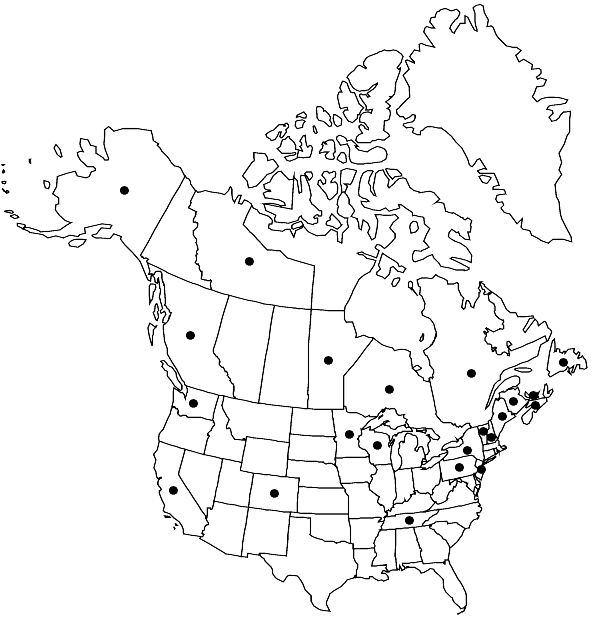Polytrichastrum formosum
Mem. New York Bot. Gard. 21(3): 37. 1971,.
Plants medium and slender to large and robust, green to dark olive green to blackish, in loose tufts. Stems (2–)3–8(–20) cm, mostly unbranched. Leaves 6–8(–12) mm, erect to erect-spreading when dry, spreading to subsquarrose and broadly recurved when moist; sheath ovate to elliptic, yellowish, hyaline-margined, gradually tapering or abruptly contracted to the blade, the cells at the shoulders forming a differentiated hinge; blade lanceolate to linear; costa prominent abaxially and toothed near the tip; excurrent as a short, toothed point; marginal lamina erect, (2–)3–5(–10) cells wide, plane or erect, sharply toothed from apex nearly to the sheath; lamellae (3–)4–5(–7) cells high, margins ± entire to finely serrulate in profile, the marginal cells in section rounded to narrowly elliptic and somewhat taller than the cells beneath, the cell walls not or moderately thickened; median cells of sheath 8–12 µm wide, narrowly rectangular, 5–7(–10):1; cells of marginal lamina subquadrate, 10–15 µm. Sexual condition dioicous or polygamous; perichaetial leaves similar to the foliage leaves, or somewhat longer, with a longer sheath. Seta 3–6 cm, yellowish to reddish brown. Capsule 4–7 mm, rather slender or short-rectangular, acutely 4(–6)-angled, inclined to almost horizontal, pale yellowish brown to brownish; hypophysis cylindric, indistinctly delimited or set off by a shallow groove; exothecium smooth or the cells weakly convex, quadrate to hexagonal, without a central thin spot; peristome 600 µm, divided to 0.6, the teeth 64 and highly regular in form or fewer and somewhat irregular, pale to brownish; epiphragm absent marginal teeth. Spores 12–16 µm.
Distribution

Widespread, temperate to cool temperate latitudes in the Northern Hemisphere.
Discussion
Varieties 3 (2 in the flora).
European treatments often assert a similarity between Polytrichastrum formosum and Polytrichum commune, which cannot be said of the North American expression of the species. The habitat and ecology of the European plants are also distinct: A. J. E. Smith (2004) described P. formosum in Britain as a common and weedy species of heaths, moorland, woods, outcrops, and old walls.
Selected References
None.
Key
| 1 | Plants often robust, 5-10(-20) cm; leaves subsquarrose and broadly spreading- recurved when moist; lamellae 5-7 cells high, entire, the marginal cells in section rounded, moderately thick-walled; capsule short rectangular; hypophysis delimited by a shallow groove; peristome teeth 64, regular in form; dioicous | Polytrichastrum formosum var. formosum |
| 1 | Plants rather slender, 3-6(-10) cm; leaves spreading when moist; lamellae (3-)4-6 cells high, the marginal cells narrowly elliptic, not or only slightly thickened; capsule slender; hypophysis not sharply delimited; peristome teeth 50-64, somewhat irregular in size and shape; monoicous (polyga- mous) | Polytrichastrum formosum var. densifolium |